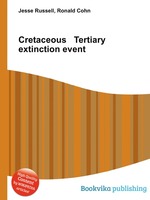Cretaceous Tertiary extinction event
Jesse Russell Ronald Cohn
бумажная книга
High Quality Content by WIKIPEDIA articles! The Cretaceous–Paleogene extinction event, formerly named and still commonly referred to as the Cretaceous-Tertiary extinction event, occurred approximately 65.5 million years ago (Ma) at the end of the Maastrichtian age of the Cretaceous period. It was a large-scale mass extinction of animal and plant species in a geologically short period of time. Widely known as the K–T extinction event, it is associated with a geological signature known as the K–T boundary, usually a thin band of sedimentation found in various parts of the world. K is the traditional abbreviation for the Cretaceous Period derived from the German name Kreidezeit, and T is the abbreviation for the Tertiary Period (a historical term for the period of time now covered by the Paleogene and Neogene periods). The event marks the end of the Mesozoic Era and the beginning of the Cenozoic Era. With "Tertiary" being discouraged as a formal time or rock unit by the International Commission on Stratigraphy, the K–T event is now called the Cretaceous–Paleogene (or K–Pg) extinction event by many researchers.


